Diarrhoea among Children Aged 5 Years and Microbial Drinking Water Quality Compliance: Trends Analysis Study in South Africa (2008–2018)
Abstract
1. Introduction
2. Materials and Methods
2.1. Study Setting
2.2. Study Design
2.3. Data Collection
2.4. Study Population (Inclusion and Exclusion Criteria)
2.5. Data Analysis
2.6. Validity and Reliability
3. Results
3.1. Descriptive Statistics
3.2. Microbial Water Quality Compliance Status Based on SANS 241:2015 Edition 2
3.2.1. National Trends of Diarrhoea in Children under 5 Years of Age in South Africa
3.2.2. Trends Analysis of Faecal Coliforms, Total Coliforms, and E. coli
Trends Per Pathogen Merged with Health Outcomes at the National Level
3.3. Pairwise Correlation
3.3.1. Pearson’s Correlation
3.3.2. Multivariate Regression
4. Discussion
5. Limitation
6. Conclusions
- Microbial water quality complying with the SANS 241:2015 Edition 2 drinking water standards, does not have a negative impact on the health of children under the age of five years in South Africa.
- The pathogenic microorganisms detected in potable water comply with the SANS 241:2015 Edition 2 stipulated limits.
- There is no correlation between microbial drinking water and the prevalence of diarrhoea, mortality, and morbidity in children under 5 years in South Africa during the study period.
- A huge decline in diarrhoeal mortality and morbidity were observed in South Africa over the study period.
Author Contributions
Funding
Institutional Review Board Statement
Informed Consent Statement
Data Availability Statement
Acknowledgments
Conflicts of Interest
References
- SANS 241-1:2015; Edition 2 Drinking Water. SABS Standards Division: Pretoria, South Africa, 2015.
- SANS 241-2:2015; Edition 2 Drinking water Part 2: Application of SANS 241-1. SABS Standards Division: Pretoria, South Africa, 2015.
- Odiyo, J.O.; Makungo, R. Chemical and microbial quality of groundwater in siloam village, implications to human health and sources of contamination. Int. J. Environ. Res. Public Health 2018, 15, 317. [Google Scholar] [CrossRef]
- Edokpayi, J.N.; Odiyo, J.O.; Popoola, E.O.; Msagati, T.A. Evaluation of microbiological and physicochemical parameters of alternative source of drinking water: A case study of nzhelele river, South Africa. Open Microbiol. J. 2018, 12, 18. [Google Scholar] [CrossRef]
- Chalchisa, D.; Megersa, M.; Beyene, A. Assessment of the quality of drinking water in storage tanks and its implication on the safety of urban water supply in developing countries. Environ. Syst. Res. 2018, 6, 12. [Google Scholar] [CrossRef]
- Wolf, J.; Hunter, P.R.; Freeman, M.C.; Cumming, O.; Clasen, T.; Bartram, J.; Higgins, J.P.; Johnston, R.; Medlicott, K.; Boisson, S. Impact of drinking water, sanitation and handwashing with soap on childhood diarrhoeal disease: Updated meta-analysis and meta-regression. Trop. Med. Int. Health 2018, 23, 508–525. [Google Scholar] [CrossRef]
- World Health Organization. Health in 2015: From Millenium Development Goals to Sustainable Development Goals. Available online: https://www.who.int/data/gho/publications/mdgs-sdgs (accessed on 19 August 2020).
- Saunders, M.N.; Lewis, P. Doing Research in Business & Management: An Essential Guide to Planning Your Project; Pearson: Toronto, ON, Canada, 2012. [Google Scholar]
- Halder, M.; Mookerjee, S.; Batabyal, P.; Palit, A. Waterborne outbreaks in diarrhoea endemic foci of India: A longitudinal exploration and its implications. Environ. Monit. Assess. 2018, 190, 172. [Google Scholar] [CrossRef]
- Hussain, Z.; Abbasi, A.Z.; Ahmad, R.; Bukhari, H.; Shahzad, M.; Sultan, F.; Ali, M. Vibrio cholerae dynamics in drinking water; mathematical and statistical analysis. Appl. Nanosci. 2020, 10, 4519–4522. [Google Scholar] [CrossRef]
- Ahmed, J.; Wong, L.P.; Chua, Y.P.; Channa, N.; Mahar, R.B.; Yasmin, A.; VanDerslice, J.A.; Garn, J.V. Quantitative Microbial Risk Assessment of Drinking Water Quality to Predict the Risk of Waterborne Diseases in Primary-School Children. Int. J. Environ. Res. Public Health 2020, 17, 2774. [Google Scholar] [CrossRef]
- Dos Santos, S.; Adams, E.; Neville, G.; Wada, Y.; De Sherbinin, A.; Bernhardt, E.M.; Adamo, S. Urban growth and water access in sub-Saharan Africa: Progress, challenges, and emerging research directions. Sci. Total Environ. 2017, 607, 497–508. [Google Scholar] [CrossRef]
- Deen, J.J.J. Epidemiology of cholera. Vaccine 2020, 38, 31. [Google Scholar] [CrossRef]
- Hasan, M.M.; Alam, K. Inequality in access to improved drinking water sources and childhood diarrhoea in low- and middle-income countries. Int. J. Hyg. Environ. Health 2020, 226, 113493. [Google Scholar] [CrossRef]
- Khalil, I.A.; Troeger, C.; Blacker, B.F.; Rao, P.C.; Brown, A.; Atherly, D.E.; Brewer, T.G.; Engmann, C.M.; Houpt, E.R.; Kang, G. Morbidity and mortality due to shigella and enterotoxigenic Escherichia coli diarrhoea: The Global Burden of Disease Study 1990–2016. Lancet Infect. Dis. 2018, 18, 1229–1240. [Google Scholar] [CrossRef]
- Sekwadi, P.; Ravhuhali, K.; Mosam, A.; Essel, V.; Ntshoe, G.; Shonhiwa, A.; McCarthy, K.; Mans, J.; Taylor, M.B.; Page, N. Waterborne outbreak of gastroenteritis on the KwaZulu-Natal Coast, South Africa, December 2016/January 2017. Epidemiol. Infect. 2018, 146, 1318–1325. [Google Scholar] [CrossRef]
- Adeniji, A.O.; Okoh, O.; Okoh, A. Distribution pattern and health risk assessment of polycyclic aromatic hydrocarbons in the water and sediment of Algoa Bay, South Africa. Environ. Geochem. Health 2019, 41, 1303–1320. [Google Scholar] [CrossRef]
- Abia, A.L.K.; Ubomba-Jaswa, E.; Momba, M.N.B. Riverbed sediments as reservoirs of multiple vibrio cholerae virulence-associated genes: A potential trigger for cholera outbreaks in developing countries. J. Environ. Public Health 2017, 2017, 5646480. [Google Scholar] [CrossRef]
- Islam, M.S.; Hassan-uz-Zaman, M.; Islam, M.S.; Clemens, J.D.; Ahmed, N. Waterborne pathogens: Review of outbreaks in developing nations. In Waterborne Pathogens; Elsevier: Amsterdam, The Netherlands, 2020; pp. 43–56. [Google Scholar]
- Hemson, D. Water, sanitation and health: South Africa’s remaining and existing issues. S. Afr. Health Rev. 2016, 2016, 25–34. [Google Scholar]
- Abia, A.L.; Schaefer, L.; Ubomba-Jaswa, E.; Le Roux, W. Abundance of pathogenic escherichia coli virulence-associated genes in well and borehole water used for domestic purposes in a peri-urban community of South Africa. Int. J. Environ. Res. Public Health 2017, 14, 320. [Google Scholar] [CrossRef]
- Baloyi, R.S.; Diamond, R.E. Variable water quality of domestic wells emphasizes the need for groundwater quality monitoring and protection: Stinkwater, Hammanskraal, Gauteng. Water SA 2019, 45, 216–224. [Google Scholar] [CrossRef]
- Worldometer. South African Population. Available online: https://www.worldometers.info/world-population/south-africa-population/ (accessed on 19 August 2020).
- Worldometer. Water Related Deaths. Available online: https://www.worldometers.info/ (accessed on 19 August 2020).
- World Health Organization. Diarrhoeal Disease. Available online: https://www.who.int/news-room/fact-sheets/detail/diarrhoeal-disease (accessed on 22 August 2020).
- World Health Organization. The Top 10 Causes of Death in Developing Countries. Available online: https://www.who.int/en/news-room/fact-sheets/detail/the-top-10-causes-of-death (accessed on 19 August 2020).
- Cheun, H.-I.; Kim, C.-H.; Cho, S.-H.; Ma, D.-W.; Goo, B.-L.; Na, M.-S.; Youn, S.-K.; Lee, W.-J. The first outbreak of giardiasis with drinking water in Korea. Osong Public Health Res. Perspect. 2013, 4, 89–92. [Google Scholar] [CrossRef]
- Hsu, B.-M.; Yeh, H.-H. Removal of Giardia and Cryptosporidium in drinking water treatment: A pilot-scale study. Water Res. 2003, 37, 1111–1117. [Google Scholar] [CrossRef]
- National Institute for Communicable Diseases. Vaccine Information for Parents & Caregivers; Cohen, C., Ed.; Ideas Wise and Wonderful for National Institute for Communicable Diseases: Johannesburg, South Africa, 2016. [Google Scholar]
- Msimang, V.M.; Page, N.; Groome, M.J.; Moyes, J.; Cortese, M.M.; Seheri, M.; Kahn, K.; Chagan, M.; Madhi, S.A.; Cohen, C. Impact of rotavirus vaccine on childhood diarrheal hospitalization after introduction into the South African public immunization program. Pediatr. Infect. Dis. J. 2013, 32, 1359–1364. [Google Scholar] [CrossRef]
- Platts-Mills, J.A.; Steele, A.D. Rotavirus vaccine impact in Africa: Greater than the sum of its parts? Lancet Glob. Health 2018, 6, E948–E949. [Google Scholar] [CrossRef]
- Rahman, M.A.; Kumar, S.; Mohana, A.A.; Islam, R.; Hashem, M.A.; Chuanxiu, L. Coliform Bacteria and Trace Metals in Drinking Water, Southwest Bangladesh: Multivariate and Human Health Risk Assessment. Int. J. Environ. Res. 2019, 13, 395–408. [Google Scholar] [CrossRef]
- Budeli, P.; Moropeng, R.C.; Mpenyana-Monyatsi, L.; Momba, M.N.B. Inhibition of biofilm formation on the surface of water storage containers using biosand zeolite silver-impregnated clay granular and silver impregnated porous pot filtration systems. PLoS ONE 2018, 13, e0194715. [Google Scholar] [CrossRef]
- Awotiwon, O.F.; Pillay-van Wyk, V.; Dhansay, A.; Day, C.; Bradshaw, D. Diarrhoea in children under five years of age in South Africa (1997–2014). Trop. Med. Int. Health 2016, 21, 1060–1070. [Google Scholar] [CrossRef]
- Bamford, L.; Barron, P.; Kauchali, S.; Dlamini, N. Inpatient case fatality rates improvements in children under 5: Diarrhoeal disease, pneumonia and severe acute malnutrition. S. Afr. Med. J. 2018, 108, 33–37. [Google Scholar]
- Chola, L.; Michalow, J.; Tugendhaft, A.; Hofman, K. Reducing diarrhoea deaths in South Africa: Costs and effects of scaling up essential interventions to prevent and treat diarrhoea in under-five children. BMC Public Health 2015, 15, 394. [Google Scholar] [CrossRef][Green Version]
- Garrib, A.; Jaffar, S.; Knight, S.; Bradshaw, D.; Bennish, M.L. Rates and causes of child mortality in an area of high HIV prevalence in rural South Africa. Trop. Med. Int. Health 2006, 11, 1841–1848. [Google Scholar] [CrossRef]
- Kapwata, T.; Mathee, A.; Le Roux, W.J.; Wright, C.Y. Diarrhoeal disease in relation to possible household risk factors in South African villages. Int. J. Environ. Res. Public Health 2018, 15, 1665. [Google Scholar] [CrossRef]
- Lewin, S.; Norman, R.; Nannan, N.; Thomas, E.; Bradshaw, D.; Collaboration, S.A.C.R.A. Estimating the burden of disease attributable to unsafe water and lack of sanitation and hygiene in South Africa in 2000. S. Afr. Med. J. 2007, 97, 755–762. [Google Scholar]
- Moropeng, R.C.; Budeli, P.; Mpenyana-Monyatsi, L.; Momba, M.N.B. Dramatic reduction in diarrhoeal diseases through implementation of cost-effective household drinking water treatment systems in Makwane Village, Limpopo Province, South Africa. Int. J. Environ. Res. Public Health 2018, 15, 410. [Google Scholar] [CrossRef]
- Reddy, K.; Patrick, M.; Stephen, C. Management of acute diarrhoeal disease at Edendale Hospital: Are standard treatment guidelines followed? S. Afr. J. Child Health 2016, 10, 215–220. [Google Scholar] [CrossRef]
- Rollins, N.C.; Ndirangu, J.; Bland, R.M.; Coutsoudis, A.; Coovadia, H.M.; Newell, M.-L. Exclusive breastfeeding, diarrhoeal morbidity and all-cause mortality in infants of HIV-infected and HIV uninfected mothers: An intervention cohort study in KwaZulu Natal, South Africa. PLoS ONE 2013, 8, e81307. [Google Scholar] [CrossRef]

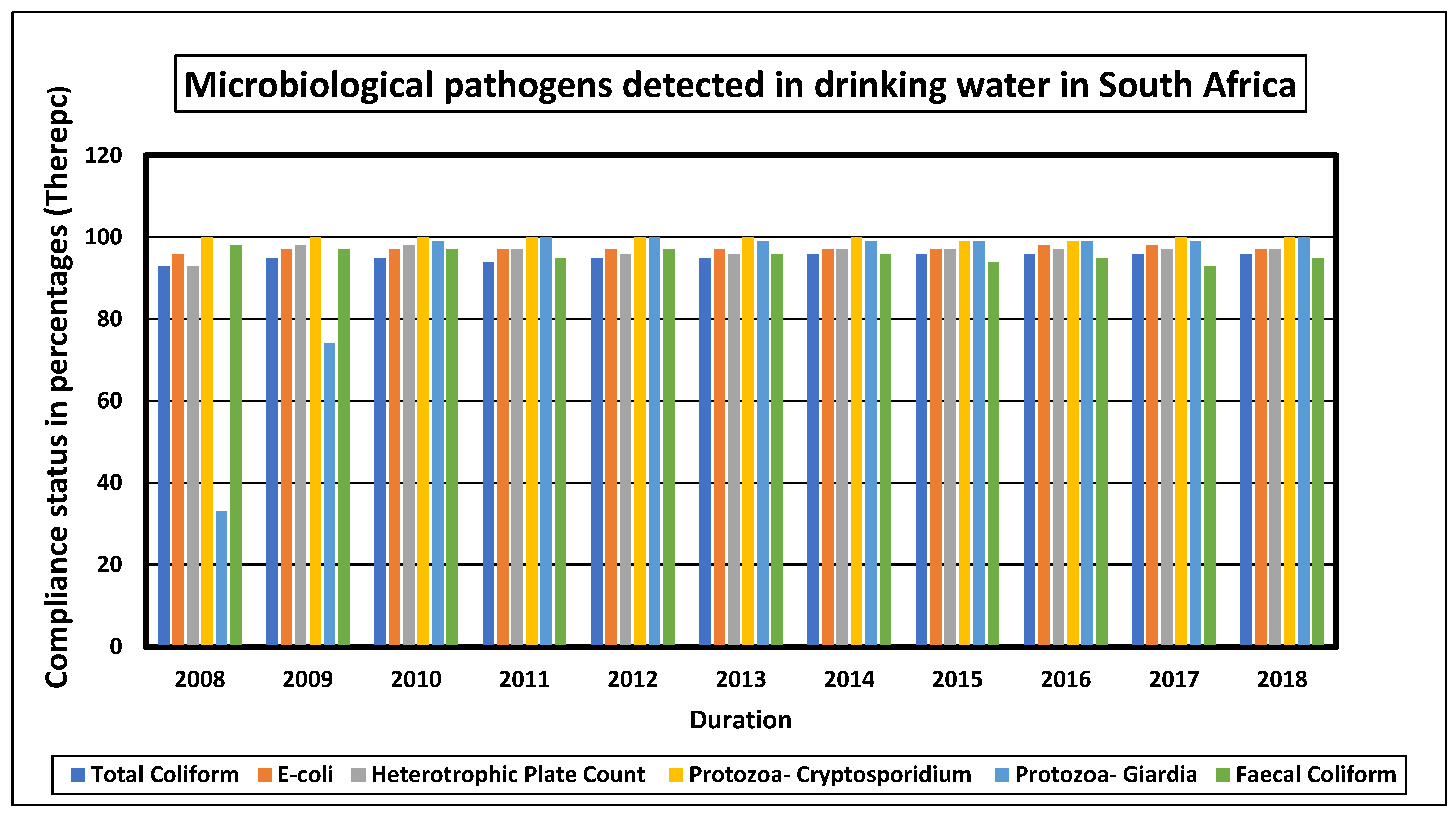
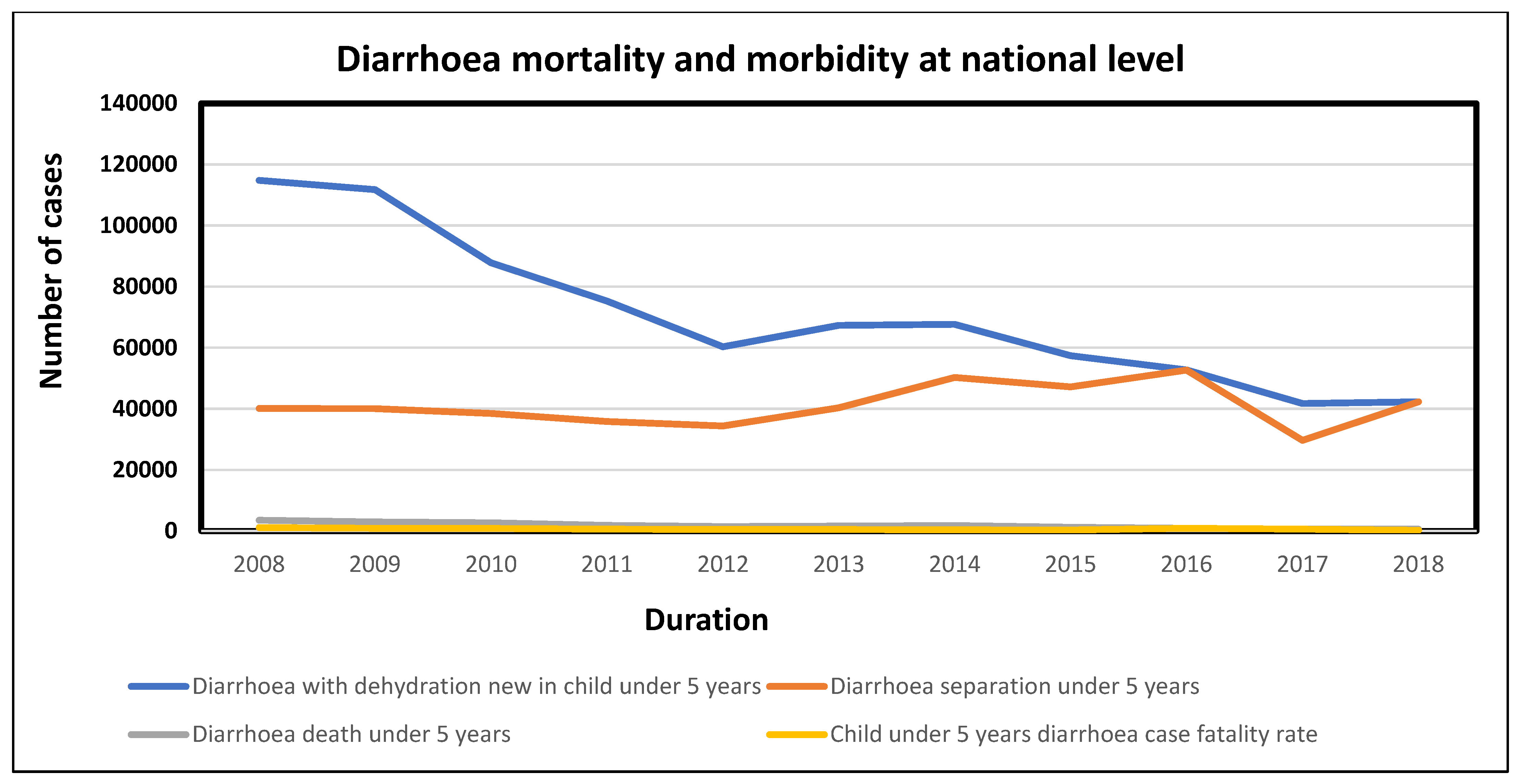
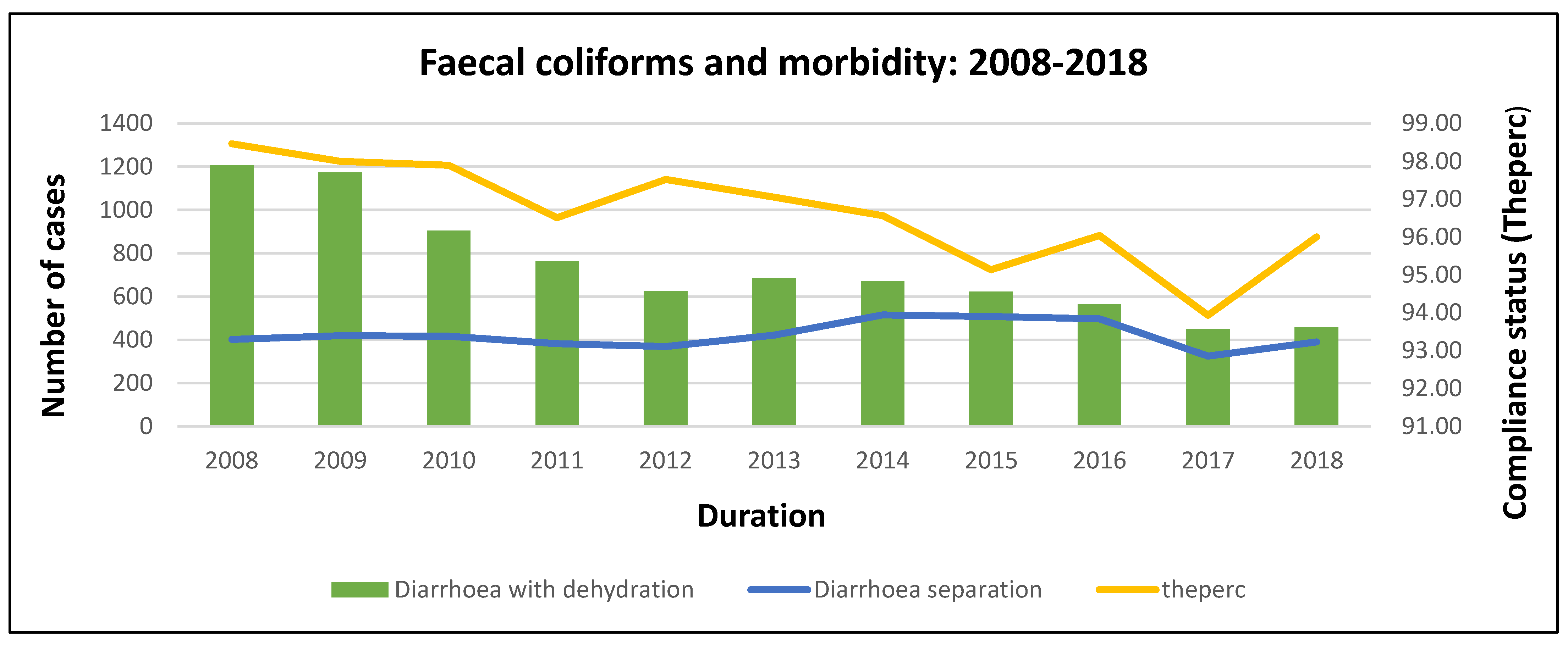
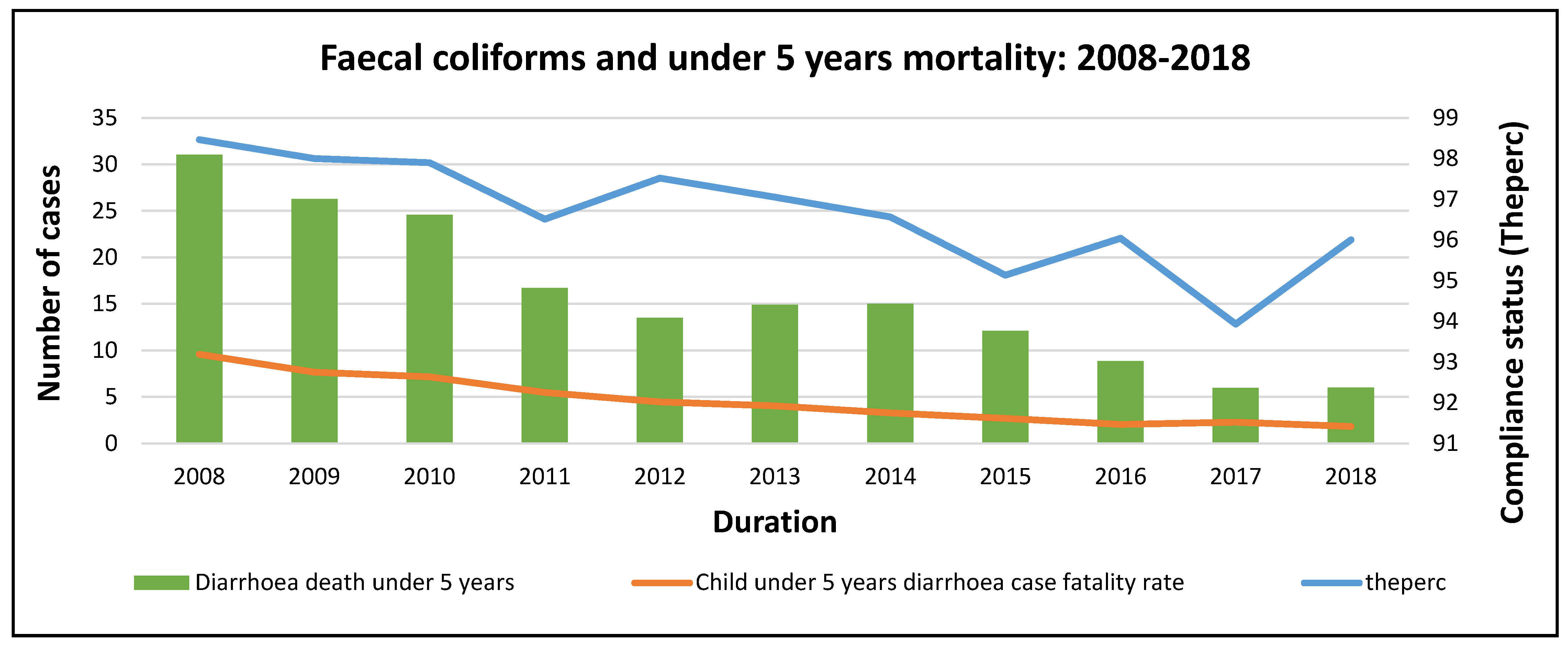
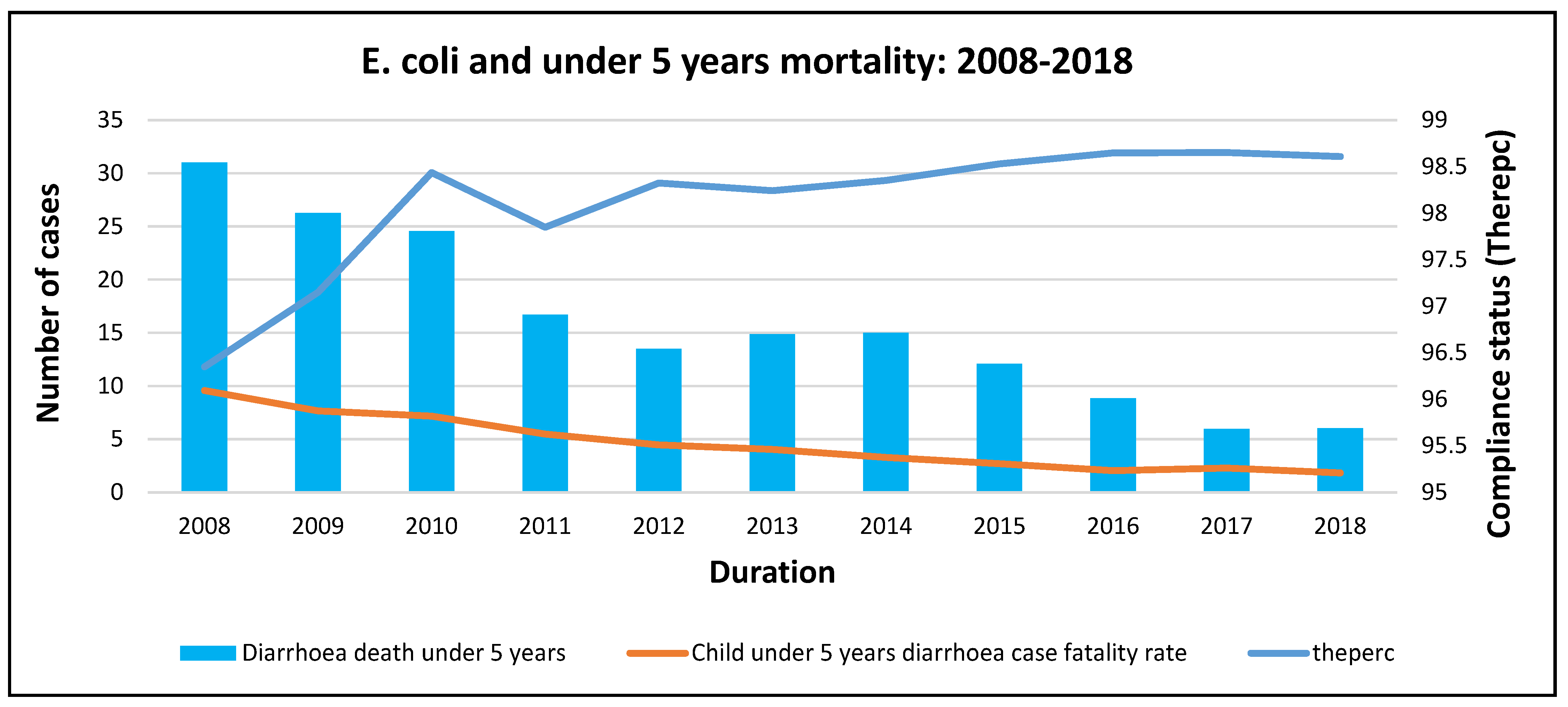
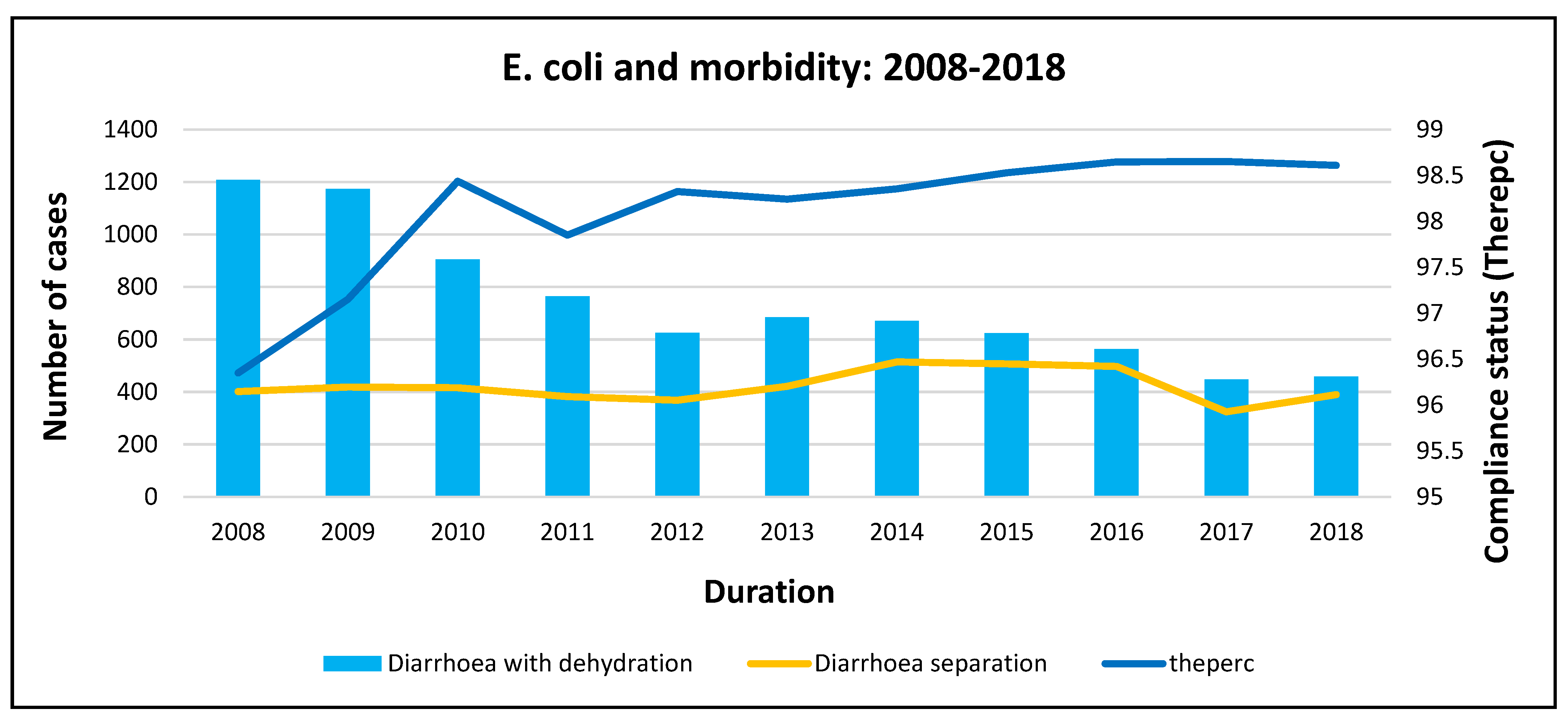

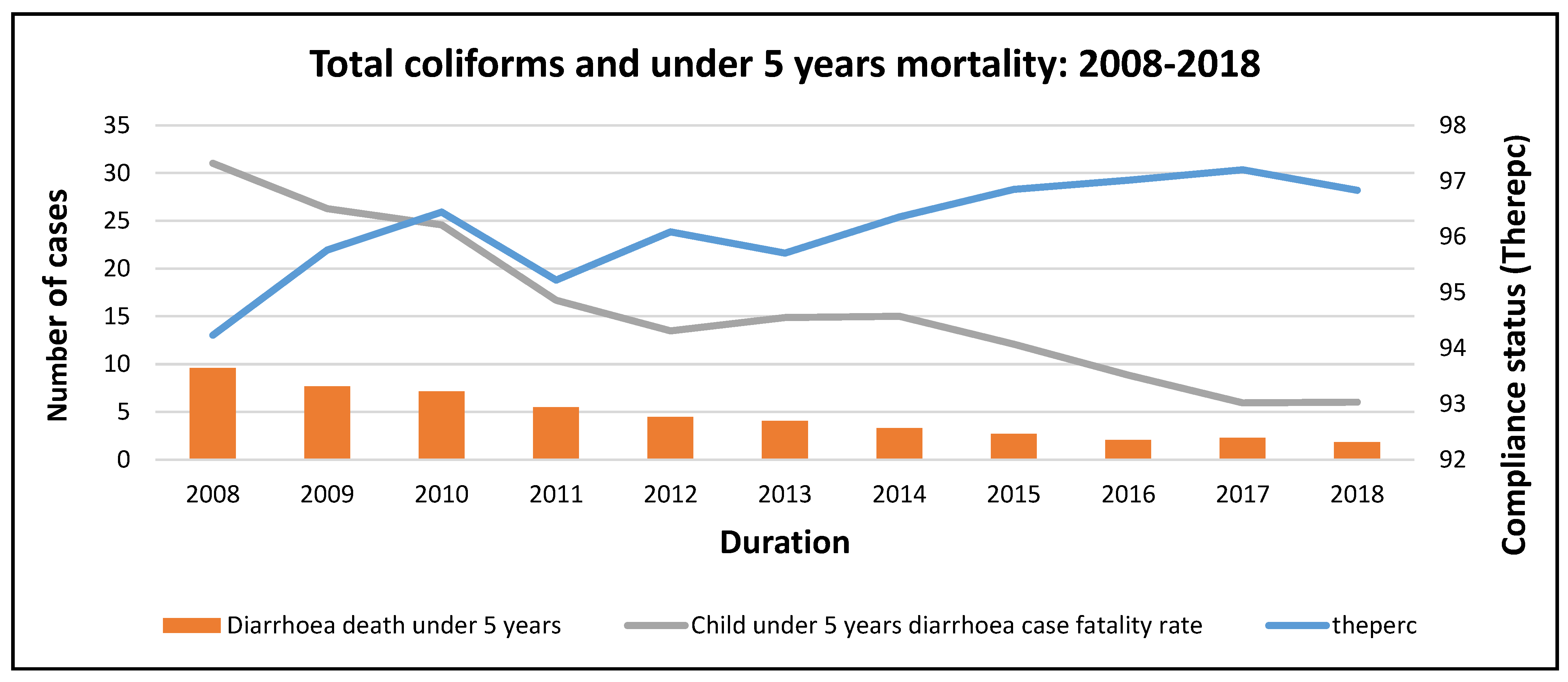
| Province | Under 5 Mortality Rates | Compliance Status (Therperc) at National Level | ||
|---|---|---|---|---|
| Mean | Std. Dev. | Mean | Std. Dev. | |
| (a) | ||||
| Limpopo | 21.59 | 11.73 | 88.55 | 10.74 |
| (b) | ||||
| Eastern Cape | 34.59 | 19.00 | 97.30 | 1.45 |
| Kwazulu-Natal | 30.09 | 12.53 | 99.45 | 0.41 |
| Free State | 14.72 | 14.89 | 98.65 | 1.18 |
| Mpumalanga | 13.74 | 7.58 | 98.44 | 0.80 |
| North West | 12.18 | 6.87 | 97.79 | 0.69 |
| Gauteng | 11.79 | 5.12 | 99.24 | 0.26 |
| Northern Cape | 2.15 | 0.64 | 99.04 | 0.73 |
| Western Cape | 2.15 | 0.64 | 99.18 | 0.52 |
| Variable | Mean | Std. Dev. |
|---|---|---|
| Diarrhoea death under 5 Years | 15.89 | 7.96 |
| Diarrhoea with dehydration new cases | 738.54 | 248.79 |
| Diarrhoea separation under 5 years | 421.80 | 58.60 |
| Case fatality | 4.590614 | 2.492427 |
| Variable | 1 | 2 | 3 | 4 | 5 | 6 | 7 |
|---|---|---|---|---|---|---|---|
| 1. Diarrhoea death under 5 years | 1 | ||||||
| 2. Analysis | 0.298 * | 1 | |||||
| 3. Compliance status | 0.236 * | 0.285 * | −0.083 | 1 | |||
| 4. Diarrhoea with dehydration new cases in children under 5 years | 0.464 * | −0.15 | 0.333 * | 0.049 | 1 | ||
| 5. Diarrhoea separation under 5 years | 0.1511 | 0.198 * | 0.417 * | 0.105 | 0.559 * | 1 | |
| 6. Diarrhoea case fatality rate | 0.724 * | 0.287 * | −0.096 | 0.226 * | −0.031 | 0.425 * | 1 |
| 7. Province | 0.539 * | −0.168 | −0.147 | 0.042 | −0.014 | 0.201 * | −0.417 |
| 8. Year | 0.519 * | 0.399 * | 0.380 * | 0.111 | 0.361 * | 0.0189 | 0.597 * |
| Diarrhoea Death under 5 years | Coefficient | Std. Err. | t | p > t | [95% Conf. | Interval] |
|---|---|---|---|---|---|---|
| Compliance status | −0.3119 | 0.112906 | −2.76 | 0.007 | −0.5362 | −0.0877 |
| Diarrhoea separation under 5 years | 0.00490 | 0.00113 | 4.31 | 0 | 0.00264 | 0.00716 |
| Diarrhoea with dehydration new cases in children under 5 years | 0.02896 | 0.00341 | 8.49 | 0 | 0.02219 | 0.03573 |
| Child under 5 years diarrhoea case fatality rate | 2.82279 | 0.22380 | 12.61 | 0 | 2.37829 | 3.26729 |
| Province | −1.6755 | 0.24380 | −6.87 | 0 | −2.1598 | −1.1913 |
| Year | 0.09245 | 0.25575 | 0.36 | 0.719 | −0.4154 | 0.60040 |
| _cons | −160.21 | 517.002 | −0.31 | 0.757 | −1187.0 | 866.593 |
Disclaimer/Publisher’s Note: The statements, opinions and data contained in all publications are solely those of the individual author(s) and contributor(s) and not of MDPI and/or the editor(s). MDPI and/or the editor(s) disclaim responsibility for any injury to people or property resulting from any ideas, methods, instructions or products referred to in the content. |
© 2022 by the authors. Licensee MDPI, Basel, Switzerland. This article is an open access article distributed under the terms and conditions of the Creative Commons Attribution (CC BY) license (https://creativecommons.org/licenses/by/4.0/).
Share and Cite
Malebatja, M.F.; Mokgatle, M.M. Diarrhoea among Children Aged 5 Years and Microbial Drinking Water Quality Compliance: Trends Analysis Study in South Africa (2008–2018). Int. J. Environ. Res. Public Health 2023, 20, 598. https://doi.org/10.3390/ijerph20010598
Malebatja MF, Mokgatle MM. Diarrhoea among Children Aged 5 Years and Microbial Drinking Water Quality Compliance: Trends Analysis Study in South Africa (2008–2018). International Journal of Environmental Research and Public Health. 2023; 20(1):598. https://doi.org/10.3390/ijerph20010598
Chicago/Turabian StyleMalebatja, Mohora Feida, and Mpata Mathildah Mokgatle. 2023. "Diarrhoea among Children Aged 5 Years and Microbial Drinking Water Quality Compliance: Trends Analysis Study in South Africa (2008–2018)" International Journal of Environmental Research and Public Health 20, no. 1: 598. https://doi.org/10.3390/ijerph20010598
APA StyleMalebatja, M. F., & Mokgatle, M. M. (2023). Diarrhoea among Children Aged 5 Years and Microbial Drinking Water Quality Compliance: Trends Analysis Study in South Africa (2008–2018). International Journal of Environmental Research and Public Health, 20(1), 598. https://doi.org/10.3390/ijerph20010598






